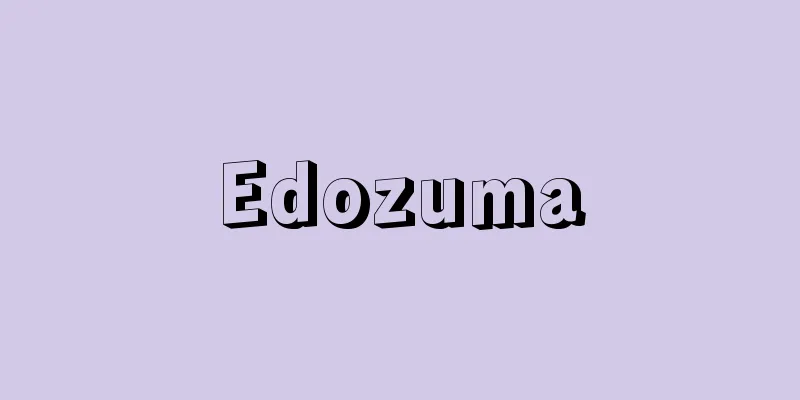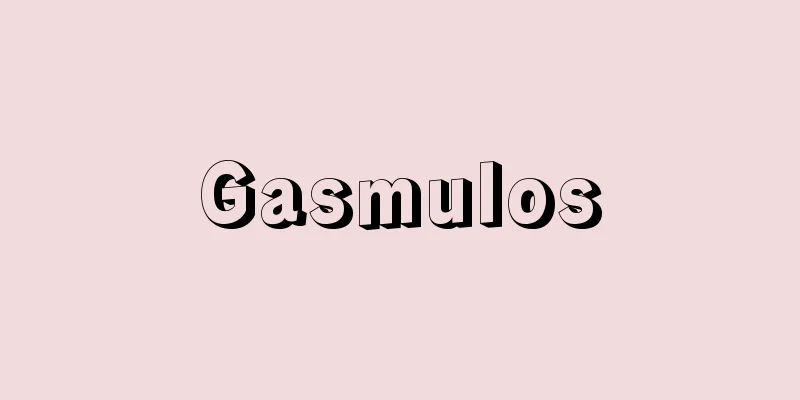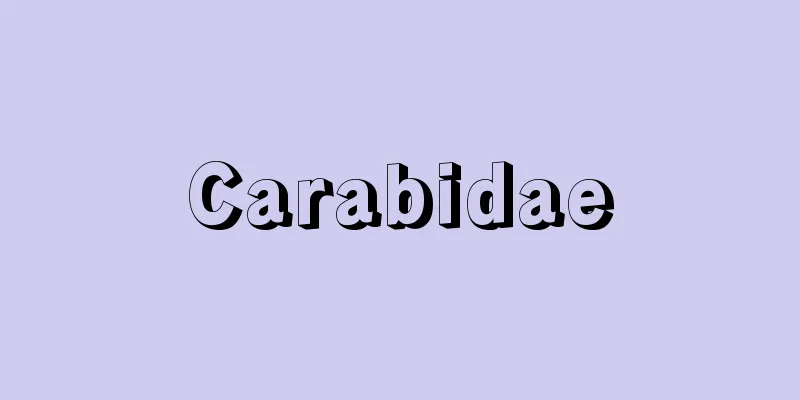Edozuma

|
One of the patterns on kimonos. Also an abbreviation of Edo-tsuma-moyo no nagagi. Today, the formal dress for married women, the Tomesode with five crests and a black background, is dyed with the Edo-tsuma-moyo pattern, so it is used as a synonym. From the Momoyama period to the early Edo period, long kimonos had all-over patterns, but around the Shotoku period (1711-1716), the term "suso" (hem pattern) began to appear. The Yuzen dyeing technique, which developed around this time, produced the high-waisted pattern with eba (patterned pattern). After that, due to the repeated bans on luxury caused by the Shogunate's austerity policies and the Edokko's taste for elegance, the patterns gradually became lower, and during the Horeki period (1751-1764), the hem patterns became 8 sun (about 30 cm from the hem), 5 sun (about 19 cm), and 3 sun (about 11 cm). Later, during the Meiwa and An'ei periods (1764-1781), patterns appeared on the front again, along with the reverse patterns that were only on the sleeve openings and hemline, and a tsuma pattern with a triangular pattern on the hem was created, which was called Edo tsuma. It is said that the pattern became popular in the Shimabara red-light district of Kyoto a little later, and patterns that extended to the collar were called Shimabara patterns. Edo tsuma patterns reached their height from the Bunka/Bunsei era (1804-1830) to the Tenpo era (1830-1844), when black crepe with a family crest became established as the formal attire for married women on celebratory occasions, a style that continues to this day. In the Meiji period, the distinction between Edo-tsuma and hoso-moyo disappeared, and they began to be used interchangeably. In the mid-Taisho period, Oedo-tsuma, which had a pattern 70-75 cm below the collar and on the back hem, and was about 30 cm high, was popular among young women and was popular. Edo-tsuma patterns were revived as formal attire again around 1955 (Showa 30), except during World War II. The placement of the pattern varies depending on age, but Oedo-tsuma is the most common, and the center of the pattern is placed high on the front body from the collar of the upper front. The main patterns are auspicious designs such as pine, bamboo, and plum, the four gentlemen, cranes and turtles, phoenixes, and Mount Horai, and are traditional, elegant, and luxurious. Unlike furisode and houmongi, there are no patterns on the upper body and sleeves. The colored Edo-tsuma, also known as Irotomesode, is the formal attire for unmarried women, as opposed to the white-collared black-crested kimono. Married women would wear it as casual attire, but nowadays it is worn for weddings and receptions for people other than family members. The fabric is a four-jo Hitokoshi crepe, and the hem is made in a plain style with the outer fabric turned inside out and stuffed with cotton. The hem has a simplified pattern that is related to the outer fabric. Originally, the undergarment was made of pure white habutae, but recently it has become common to use a hidden plaited kimono. In summer, the undergarment is made of plain silk or silk crepe, with white plain silk used as the undergarment. [Kazuko Okano] [Reference] |Formal attire for married women. Around 1955, Oedo-tsuma with patterns extending to the back became more common. ©Shogakukan Edo Source: Shogakukan Encyclopedia Nipponica About Encyclopedia Nipponica Information | Legend |
|
着物の模様付けの一つ。また江戸褄模様の長着の略。今日では既婚女性の正装である黒地染抜き五つ紋付の留袖が、江戸褄模様に染められているので、同義語として用いられる。 桃山時代から江戸初期には、長着は総模様であったが、正徳(しょうとく)年間(1711~1716)ごろになると裾(すそ)模様の名が現れる。このころ発達した友禅染が絵羽模様の腰高模様を生み出したのである。その後、幕府の緊縮政策によるたび重なる奢侈(しゃし)禁令と江戸っ子の粋(いき)好みから、模様はだんだん低くなり、宝暦(ほうれき)年間(1751~1764)には八寸(裾から約30センチメートル)、五寸(約19センチメートル)、三寸(約11センチメートル)の裾模様となった。その後明和(めいわ)・安永(あんえい)期(1764~1781)になると、袖(そで)口、裾回しのみ模様を置いた裏模様と並んで、ふたたび表に模様が現れ、褄(つま)の部分に三角に模様を置く褄模様ができ、これを江戸褄といった。やや遅れて京都島原の遊廓(ゆうかく)あたりから流行したといわれる、衿(えり)まで模様のかかるものは、島原模様といった。 江戸褄模様は、文化・文政(1804~1830)から天保(てんぽう)(1830~1844)にかけて全盛となり、定紋付黒縮緬(ちりめん)が既婚女性の慶事の礼装として定着し、現在に至っている。 明治になると、江戸褄模様と裾模様の区別がなくなり、混用されるようになった。大正中期には大江戸褄といって、衿下70~75センチメートル、後ろ裾に模様がかかり、その模様の高さも30センチメートルほどのものが若い女性に好まれ、流行した。江戸褄模様は第二次世界大戦中を除き、戦後の1955年(昭和30)ごろからふたたび正式礼装として復活した。年齢により模様の位置に高低があるが、大江戸褄がほとんどで、模様の中心は上前の衽(おくみ)から前身頃(みごろ)に高く置かれるようになった。模様は松竹梅、四君子(しくんし)、鶴亀(つるかめ)、鳳凰(ほうおう)、蓬莱山(ほうらいさん)などの吉祥(きちじょう)模様がおもで、伝統的で格調の高い豪華なものである。なお振袖や訪問着と異なり、上部身頃と袖には模様がない。白衿黒紋付に対して色物の江戸褄は色留袖ともいい、未婚女性の正装である。これを既婚者が着ると略装とされたが、現在では身内以外の者の結婚式や披露宴などに着られる。 生地は一越縮緬(ひとこしちりめん)の四丈物を用い、裾回しは表地を裏に引き返して用いる無垢(むく)仕立てで、口綿入れにする。裾回しには表と関連のある模様を簡略にしたものをつける。 本来は下着には白羽二重(はぶたえ)の無垢を重ねるが、最近は比翼(ひよく)仕立てにすることが多い。夏は平絽(ひらろ)か絽縮緬の単(ひとえ)で、下着には白の平絽を用いる。 [岡野和子] [参照項目] |既婚女性の礼装。昭和30年ごろから模様が後身頃まで延びた大江戸褄が多くなった©Shogakukan"> 江戸褄 出典 小学館 日本大百科全書(ニッポニカ)日本大百科全書(ニッポニカ)について 情報 | 凡例 |
Recommend
Law of chemical equilibrium
For the chemical reaction a A + b B + …⇄ p P + q ...
Zorn, MA (English spelling) ZornMA
...That is, for each ordinal number α, we can ass...
cheliped
…The terminal segment is a movable finger that in...
Silesian Weavers' Revolt - Silesian Weavers' Revolt
An uprising of linen and cotton weavers took place...
《Space Battleship Yamato》
...In particular, Mushi Production's works pr...
Corvus macrorhynchos connectens (English name)
… [Yukio Taniguchi]. … *Some of the terminology t...
schola cantorum (English spelling) scholacantorum
The Church is a community of singers in the Chris...
ex libris (English spelling) exlibris
…In rare cases, pieces of leather are used. The L...
Octoecos - Octoecos
...The system of modes (which developed especiall...
Information
...As already mentioned, these concepts were only...
"Phenomenology of Scientific Discovery"
...It was emphasized that a fact can only be &quo...
Latouchia typica (English spelling) Latouchia typica
…[Izumi Kayashima]. … *Some of the terminology th...
Filippo Brunelleschi
Italian architect and sculptor. His real name was...
Schlafmoos
...There is also an opinion that it is based on t...
Camerarius - Rudolph Jakob Camerarius
A German pharmacologist and pioneering researcher...









